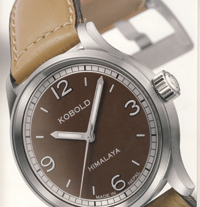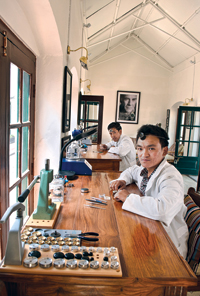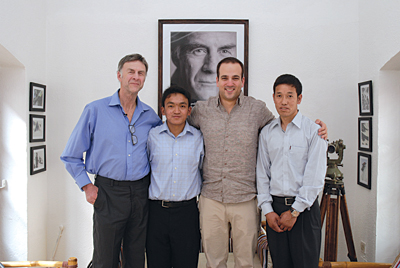A journey of two Sherpas from mountaineering guides to watchmakers.
In 2009, Sir Ranulph Fiennes, the renowned English adventurer, became the oldest Briton to climb Mount Everest. While in the Mount Everest Base Camp another idea struck him. Even for a man who has earned a reputation for carrying out seemingly impossible plans (Ran has run seven marathons on seven continents in seven days—just five months after suffering a heart attack that required him to have double bypass surgery) the idea was absurd. He approached his friend, Michael Kobold, a watchmaker, with the idea to train two Sherpa men to become watchmakers. The two Sherpas that Ran had in mind were Ang Namgel Sherpa and Lakpa Thundu Sherpa. They were the guides for Kobold and Ran respectively on that expedition. “If Thundu and Namgel don’t have to climb this mountain anymore, their families surely will sleep better at night,” Ran said. Michael Kobold, the founder of Kobold Watch Company, agreed.
 Ang Namgel Sherpa and Lakpa Thundu Sherpa were both from Khumjung, in the Solukhumbu District. They had become guides on Everest more out of necessity than choice. Belonging to poor families, not many doors were open to them: Namgel could not continue his studies after passing the SLC examinations; Thundu had dropped out of school before reaching the secondary level. Namgel had an uncle in the mountaineering business and he persuaded Namgel to accompany him on expeditions. Although a novice in mountaineering with no alpine training, it took Namgel only a year before he attempted an ascent of Big E. Namgel successfully climbed Everest in 2006, aged 21. Namgel was soon going on expeditions on Everest during springs. He spent autumns on other mountains, scaling Mount Cho Oyu (8,201 meters above sea level), Mount Manaslu (8, 156 meters above sea level) twice, and Ama Dablam (6,812 meters above sea level) four times.
Ang Namgel Sherpa and Lakpa Thundu Sherpa were both from Khumjung, in the Solukhumbu District. They had become guides on Everest more out of necessity than choice. Belonging to poor families, not many doors were open to them: Namgel could not continue his studies after passing the SLC examinations; Thundu had dropped out of school before reaching the secondary level. Namgel had an uncle in the mountaineering business and he persuaded Namgel to accompany him on expeditions. Although a novice in mountaineering with no alpine training, it took Namgel only a year before he attempted an ascent of Big E. Namgel successfully climbed Everest in 2006, aged 21. Namgel was soon going on expeditions on Everest during springs. He spent autumns on other mountains, scaling Mount Cho Oyu (8,201 meters above sea level), Mount Manaslu (8, 156 meters above sea level) twice, and Ama Dablam (6,812 meters above sea level) four times.
 Thundu was similarly gifted. He started out as a trek guide. But in 2000 he found work as a cook for an expedition at Base Camp II, which is situated at 6,200 meters above sea level. The sardar of that expedition sensed that Thundu had what it took to climb Everest. The following year Thundu was given a chance to climb Everest and he successfully reached the summit from the north side. He was 28. In 2002, he climbed Annapurna I (8,091 meters). He has scaled Cho Oyu and Manaslu twice, and Ama Dablam an impressive seven times.
Thundu was similarly gifted. He started out as a trek guide. But in 2000 he found work as a cook for an expedition at Base Camp II, which is situated at 6,200 meters above sea level. The sardar of that expedition sensed that Thundu had what it took to climb Everest. The following year Thundu was given a chance to climb Everest and he successfully reached the summit from the north side. He was 28. In 2002, he climbed Annapurna I (8,091 meters). He has scaled Cho Oyu and Manaslu twice, and Ama Dablam an impressive seven times.
Between them, Namgel and Thundu have climbed Everest an astounding 16 times (Namgel nine times and Thundu seven). But they are equally formidable as a team. The duo’s last expedition was in 2010. They were in Tibet to climb Shishapangma (8,013 meters above sea level). Unfortunately, they had to abandon the climb due to bad weather.
 But it wasn’t their climbing prowess that set them apart from other climbers. In 2010, a year after his successful ascent, Michael Kobold returned to Everest. He was accompanied by his wife. Namgel and Thundu were the couple’s guides. The couple made it to the summit. But on reaching base camp, Kobold’s wife made the mistake of not changing her clothes before sleeping. Because her clothes were drenched in sweat, hypothermia set in. Although Namgel and Thundu hadn’t slept since setting out with Kobold and his wife for the summit over 24 hours ago, they kept a vigil for hours to look after Kobold’s wife. By the time she finally felt better again the Sherpas had not slept for over 48 hours.
But it wasn’t their climbing prowess that set them apart from other climbers. In 2010, a year after his successful ascent, Michael Kobold returned to Everest. He was accompanied by his wife. Namgel and Thundu were the couple’s guides. The couple made it to the summit. But on reaching base camp, Kobold’s wife made the mistake of not changing her clothes before sleeping. Because her clothes were drenched in sweat, hypothermia set in. Although Namgel and Thundu hadn’t slept since setting out with Kobold and his wife for the summit over 24 hours ago, they kept a vigil for hours to look after Kobold’s wife. By the time she finally felt better again the Sherpas had not slept for over 48 hours.
Soon after their selfless act, Kobold invited the altruistic duo to the States to train at the Kobold Watch Company facilities in Pittsburgh. In March 2011, Namgel and Thundu flew to the U.S. to begin their training in watch-making.
Michael Kobold remembers their anxiety about traveling outside their country for the first time. “We don’t feel safe traveling without you,” Namgel and Thundu told Michael over the phone after receiving their visas for the U.S. Kobold traveled with them to the States. Flying for the first time ever, the Sherpas had brought along food with them for the trip. They had also brought prayer flags, prayer wheels and other paraphernalia that they would usually carry while climbing. ‘It occurred to me,’ Kobold wrote of the sight of the duo with all that stuff on the plane, ‘that Namgel and Thundu might erect a puja pole in the cabin and set off the smoke detectors with a juniper fire before take-off.’
Child-like on the plane, the Sherpas proved precocious craftsmen once they began their training at the Kobold’s Watch Company in Pittsburgh. Kobold knew the two were gifted watchmakers when they assembled a watch by the end of their first week. Namgel and Thundu astounded everyone with their speed. When I asked them about this feat, they were humble. “It was difficult in the beginning,” says Namgel. “Some tiny part would spring out from the table and we had to then look for it.” The duo trained at the Kobold Watch Company, completing a two year course in 11 months.
Now, they run a shop in Kathmandu, at Baber Mahal Revisited. Talking to them in this quiet room, I couldn’t help but wonder how they felt about their new lives. “Our families are happier now,” said Namgel. They spoke excitedly of the cities they had visited in the U.S. “In California there is greenery year round. Pittsburgh gets snow like our village. But we didn’t see mountains there,” said Thundu. Although they are cheerful about the prospects of making and selling watches, their love for mountaineering remains. “Sometimes in the climbing season [spring] I miss climbing mountains. Climbing was dangerous but it was also fun. We were always on the move. We met a lot of people and made many friends,” says Thundu.
Namgel and Thundu have brought back a few watches they assembled in the States. The watch – named Himalaya – bears the ‘Made in Nepal’ mark. Kobold only makes watches with automatic winding mechanism. Their watches are very expensive, with a starting price of $3,500. Namgel told me that they had already received two orders for the watch, which they will begin making soon in their shop in Kathmandu. Making expensive watches and selling them in a country like Nepal is a daunting venture. But Namgel and Thundu are relaxed and confident. Theirs is the same optimistic and determined attitude that has come to be associated with Sherpas since the first expedition marched into the Everest region. They may be working in lower altitudes than they have been used to but their sights are once again set high.










